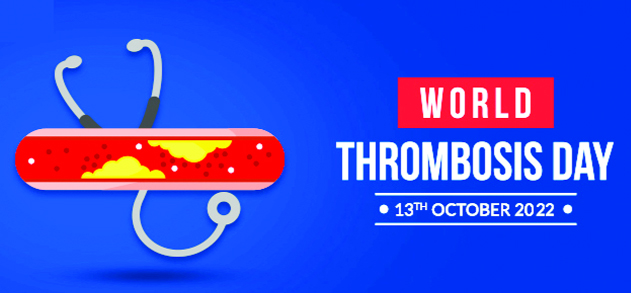Dr Arvind Kohli
Recognized on 13 October, the birthday of Rudolf Virchow, pioneer in the pathophysiology of thrombosis, World Thrombosis Day (WTD) focuses attention on the often overlooked and misunderstood disease of thrombosis.1 in 4 people worldwide are dying from conditions caused by thrombosis. And, it’s a startling fact that this number is greater than the total number of people who lose their lives each year to AIDS, breast cancer, and motor vehicle crashes combined.
WHAT IS THROMBOSIS?
Thrombosis is the formation of a blood clot in a blood vessel. The vessel may be any vein or artery as for example, in a deep vein thrombosis (venous) or a coronary artery (arterial). The clot itself is termed a thrombus.Once formed, a blood clot can slow or block normal blood flow, and even break loose and travel to an organ. A clot that travels to the circulation is called an embolism.Arterial Thrombosis can lead to pathology of heart attack, thromboembolic stroke or paralysis, Deep vein thrombosis (DVT) is a blood clot that occurs in a deep vein, usually in the lower leg, thigh, pelvis, or arm. A DVT can occur without any symptoms, but it is often accompanied by swelling, pain, and redness of the skin. If a DVT is not treated, a part of the clot can break off and travel to the lungs, causing a blockage in the lungs called a pulmonary embolism (PE)
Why is there limited awareness about blood clots?Many people do not know much about blood clots and are not familiar with the signs and symptoms until it happens to them or someone they know. In addition, the signs and symptoms of a DVT and PE are similar to other health problems and can be misdiagnosed as other health conditions. A misdiagnosis can lead to delayed treatment of a DVT, resulting in a PE or even death. Understanding risk for a blood clot and the signs and symptoms can help patient seek treatment at the earliest sign of a blood clot to prevent any complication
Who is at risk for a blood clot Blood clots can affect anyone at any age, but certain risk factors, such as surgery, hospitalization, pregnancy, cancer and some types of cancer treatments can increase risks. In addition, a family history of blood clots can increase a person’s risk. Medical diseases which affect blood rheology are important causes
DIAGNOSIS
The clinical diagnosis of DVT is generally inaccurate, especially in the inpatient setting. Of patients undergoing ultrasound “to rule out DVT”, only about 15% are found to have one
D-dimer assessment is useful to eliminate the possibility of DVT. Plasma D-dimers are derivatives of fibrin degradation products and are found to be raised in patients with thromboembolism. Plasma D-dimer assay has very high sensitivity but poor specificity for venous thrombosis and hence a patient with low probability of DVT with a negative D-dimer test has almost no chance of having venous thrombosis.
Duplex ultrasonographyalso called Doppler test has replaced venography as the investigation of choice in diagnosing DVT. It is cheap, easily available, and non-invasive. However, it does have some disadvantages that need to be kept in mind – diagnosis of isolated calf vein DVT and evaluation of iliac veins is often dependent on operator experience, patient habitus, and the clinical situation. Despite these limitations, a negative report from a single, technically adequate ultrasound examination is sufficient grounds to withhold anticoagulation therapy.
Computerized tomography (CT) pulmonary angiography is the most useful test for detecting a pulmonary embolus. It can be combined with CT venography as a single scan to diagnose both PE and DVT.
TREATMENT
Once the diagnosis of DVT has been established, treatment involves anticoagulation to encourage clot lysis and recanalization and prevent re-thrombosis and embolization.
Low molecular weight heparins (LMWH) are derivatives of unfractionated heparin formed by depolymerization. The advantage they have over unfractionated heparin is that the anticoagulant response to a standard dose of LMWH is consistent and predictable and hence does not require monitoring during therapy. Also, the half life of these drugs is longer and once-daily dosage is possible. and the risk of bleeding related complications appears to be less Continued anticoagulation is usually maintained using oral warfarin.
Newer Oral Anticoagulants The new oral anticoagulants (NOACs), which include dabigatran, rivaroxaban, apixaban, and edoxaban, are poised to replace warfarin for treatment of the majority of patients with venous thromboembolism (VTE). With a rapid onset of action and the capacity to be administered in fixed doses without routine coagulation monitoring, NOACs streamline VTE treatment The NOACs represent an important advance in VTE treatment. By streamlining transition of care, they facilitate out-of-hospital treatment and are easier to use and safer than warfarin Finally, the utility of the NOACs for VTE treatment in vulnerable patients, such as those who are morbidly obesity, those of very low body weight, pregnant women, nursing mothers, those with serious thrombophilic defects, or those requiring concomitant antiplatelet therapy, remain to be established
PULMONARY EMBOLISM
Fatal PE is the most dramatic effect of VTE and remains the most common preventable cause of death in hospitalized patients. The best strategy is prevention by adequate prophylaxis for VTE. Early detection is essential for improved out come and requires a high degree of suspicion, when patients have: Unexplained tachycardia Unexplained fever Chest pain Dyspnea Hemoptysis
Treatment of PE is decided by the cardiovascular status of the patient. If the patient has circulatory collapse then he is best managed by catheter directed thrombolysis or thrombectomy. If the patient is stable than adequate anticoagulation is sufficient.
World Thrombosis day theme
The theme for World Thrombosis Day 2022 is “Eyes Open to Thrombosis.” This theme emphasizes the need to be alert and recognise the early warning signs of thrombosis before it becomes worse.
(The author is CT &Vascular Surgeon GMC Jammu)
Trending Now
E-Paper


